Peter Insole
Western Thunderer
Thank you Brian! I promise, I promise!
There weren't any tears this afternoon either...
It started in smelly - and slightly curling style:
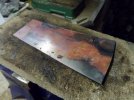
The rest happened so quickly that I forgot to grab the camera!
Once it had cooled down, the copper was so nice and soft that I was able to form it all around the timber core with nothing more than a finger and thumb! The only time I used a hammer was to gently, and slightly untidily tap a joggle into the lapped joint - that thankfully will be quite invisible down the back.
The only disappointment was that the flux flowed too freely around the pipe during soldering up, and cleaned most of the fresh "patina" off again when washing!
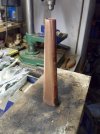
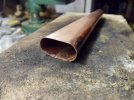
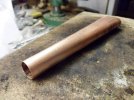
I will have to work out some way of cold "pickling" for the finished pipe to make it go mucky again, as now it has come out so nicely, I don't want to warp it or spoil the solder joint by blasting it all over with the gas torch for a second time!
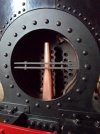
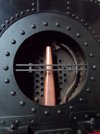
I really did think that was going to be a terrible battle, and was being very careful to ensure that I still had enough spare left on the small copper sheet for another go at it!
Still utterly amazed, and quite - well actually I do admit, somewhat more than a bit chuffed with my little chuffer!
Pete.
There weren't any tears this afternoon either...
It started in smelly - and slightly curling style:

The rest happened so quickly that I forgot to grab the camera!
Once it had cooled down, the copper was so nice and soft that I was able to form it all around the timber core with nothing more than a finger and thumb! The only time I used a hammer was to gently, and slightly untidily tap a joggle into the lapped joint - that thankfully will be quite invisible down the back.
The only disappointment was that the flux flowed too freely around the pipe during soldering up, and cleaned most of the fresh "patina" off again when washing!



I will have to work out some way of cold "pickling" for the finished pipe to make it go mucky again, as now it has come out so nicely, I don't want to warp it or spoil the solder joint by blasting it all over with the gas torch for a second time!


I really did think that was going to be a terrible battle, and was being very careful to ensure that I still had enough spare left on the small copper sheet for another go at it!
Still utterly amazed, and quite - well actually I do admit, somewhat more than a bit chuffed with my little chuffer!
Pete.










